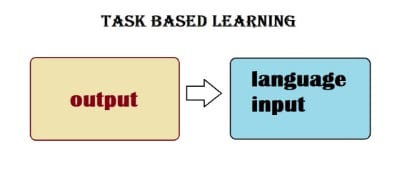Apart from the more traditional PPP (Present, Practice, Produce) approach there is a great number of different methods and approaches to teaching ESL. One of subcategories of communicative language teaching is TBL (task-based learning). Although it has been used for many years, its popularity has dramatically increased in recent years. This article presents an overview of this approach.

Van den Branden defines task-based language learning as “an approach to language education in which students are given functional tasks that invite them to focus primarily on meaning exchange and to use language for real-world, non-linguistic purposes”. In other words, TBL refers to an approach to teaching and learning which views the completion of meaningful tasks through authentic communication as an effective way to improve language proficiency in the natural, practical, and functional use. Task-based language learning and teaching give students something real to do using the language they are learning. Such tasks can include visiting a doctor, planning a tour, conducting an interview. Assessment is primarily based on task outcome rather than on accuracy of prescribed language forms, therefore there is no prior focus on language. This makes TBLT especially popular for developing target language fluency and student confidence.
What are the advantages of TBL?
1. The focus of the learning process moves from a teacher to students. Students themselves decide on the content of the task and they are free of language control. The role of the students is far from being one of the passive recipients of comprehensible input; students are now seen to take the leading role in their own learning, learners are autonomous to negotiate course content or to choose linguistic forms when performing a task. Teachers just address students’ needs and interests by becoming facilitators / guides.
2. It can bring teaching from abstract knowledge to real world application, a natural context. It promotes real communication or the exchange of meanings rather than linguistic forms.
3. It gives the student a different way of understanding language as a tool instead of as a specific goal.
4. It is a strong communicative approach where students spend a lot of time communicating.
5. TBL involves many different skills and knowledge.
6. It brings a variety to your lessons and motivate students greatly.
What are the disadvantages of TBL?
1. Potentially unpredictable as it is impossible to plan 100% what language the students will use during the task, therefore the teacher should be very flexible.
2. Time-consuming. Doing a task might extend over longer periods of time, more than just one lesson. If you want your students to make a poster or a video, they will have to do after the lesson in their free time.
A framework of a TBL lesson
Pre-task
In the pre-task, the teacher introduces the topic, gives instructions and presents what will be expected of the students in the task phase.
Skehan distinguishes between the ‘weak’ and ‘strong’ versions of TBLT approach. In weak end version a model of the task is shown before the students do it, the teacher may help the students to recall some key vocabulary or grammatical constructions. Moreover, teachers may present a model of the task by doing it themselves or by presenting pictures, audios, or video demonstrating the task. This gives the students a clear model of what will be expected of them. In «strong» task-based learning lessons, learners are responsible for selecting the appropriate language for any given context themselves.
Task cycle
- According to Willis, the most important is to choose a meaningful task which is related to real world activities. It should provide an opportunity to exchange information with a focus on meaning and have a clear purpose (students know the outcome they are expected to produce). The students complete a task in pairs or groups.
Example of a task:
Your class wants to organise a sightseeing tour for foreign students. With your partner (in a group) make a map with interesting places in your city. Be ready to explain why you’ve chosen these places. - Then students plan how they are going to report it to the rest of the class or to other groups. They prepare a short oral or written report, it might be a short speech, a video or a poster. Students can also practice their speaking before reporting the task, therefore, they feel more confident. The teacher’s role is typically limited to an observer, they monitor, observe and clear up any language questions students may have.
- As a report students give a presentation of the task, exchange written reports, compare results and so on. The teacher chooses the order of when students will present their reports and may give the students some quick feedback on the content.
Language focus
- The teacher attracts students’ attention to some patterns, vocabulary, grammar that emerged during the report or gives input on the ‘gap’ between what language the students used and the language which would be more relevant in the task. They discuss and analyse the language.
- Then the teacher conducts practice of new language depending on the needs of the students. The students then do practice activities to increase their confidence and make a note of useful language.
TBL lesson demo:
The teacher uses a task based approach to present the use of Passive Voice.
Task-based lesson on speaking:
A night out
As Jane and Dave Willis say the “the best way to learn about TBL is to DO it.”
Hope you will enjoy TBL lessons. If you have already tried this approach, please write about your experience in comments.






 Вероника Аветисян
Вероника Аветисян 
 Маргарита Аветисян
Маргарита Аветисян 


